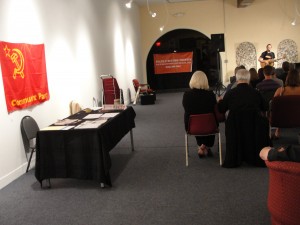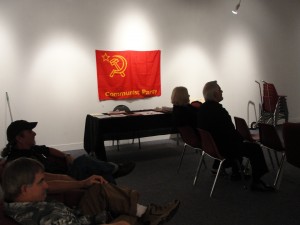– from Zoltan Zigedy is available at:
http://zzs-blg.blogspot.com/
Jack Rasmus’ new book, Obama’s Economy (PlutoPress, 2012), is a marked departure from his earlier volume, Epic Recession: Prelude to Global Recession (PlutoPress, 2010). Where the earlier effort sought to provide a theoretical framework to understand the worldwide economic crisis that began over four years ago, the new book offers a detailed, critical history of President Barack Obama’s policy responses to that crisis. In fact, much of Obama’s Economy reads like a vivid, insightful diary of economic life during that period. Rasmus links these events into a powerful narrative that was easy to miss as we lived it.
This blow-by-blow account of economic decline and feeble policy response is all cast in the shadow of Obama’s campaign promises, promises that were neither bold nor progressive. As Rasmus demonstrates, Obama — the candidate – drew his financial support from Wall Street, surrounded himself with corporate-friendly, free-market-oriented advisers, and preferred caution and compromise to any bold, new vision:
Another clear conclusion from the campaign period is that once Obama had all but sewn up the nomination, he began a shift even further to the right. This was not unnoticed, even by the ultra-conservative editorials in the Wall Street Journal, not to mention columns by liberal economists like Krugman. To the extent that candidate Obama’s election-period programs were “populist†in any sense, they were positions largely borrowed from his Democratic opponents in the primaries. Most of these populist elements were de-emphasized in the fall election period, or soon after the election. Few would appear in his eventual 2009 first economic recovery program. (p. 33-34)
Beyond Rasmus’ account and well before the Presidential candidacy, Obama’s career was marked by sycophancy to power and wealth and by opportunism. What is truly pathetic is that so many who willfully overlooked the stark evidence and chose to embrace a Pollyanna picture of hope and change are now outraged at an imagined but non-existent “betrayal.†As Rasmus demonstrates, Obama’s economic course was largely predictable from his campaign promises. But then liberals and most progressives have been dining on the thin gruel of imagined Democratic Party “leftism†for decades. And they are at it again in this election cycle.
Rasmus sifts through the seeming chaos and improvisations of the last four years to find three distinct Obama recovery programs implemented in 2009, 2010, and 2011. In addition, Obama’s Economy identifies “two and a half†Federal Reserve actions (Quantitative Easings) meant to revive the slumping economy. It is Rasmus’s considered opinion that all these efforts failed to restore the US economy to anything like a sustainable vitality. The current abysmal state of the global economy and the sluggishness of the US economy would certainly suggest that Rasmus is right.
Further, he chronicles the bi-partisan, near-consensual debt-reduction mania that emerged in 2011, a development that found politicians competing with one another to suggest severe budget cutting and program elimination. Rasmus takes this anti-stimulative austerity to augur a “double dip†recession: a forthcoming decline in gross domestic product no later than 2013. In this, he is in agreement with the May 22, 2012 statement by the staid Congressional Budget Office which predicts a GDP contraction in the first two quarters of 2013 unless federally legislated measures are rescinded (the equally draconian state and municipal austerity programs are not a factor in the CBO calculations).
After reading Rasmus’ new book, one will find little to justify praise for the Obama administration. While the three trillion dollars of recovery programs (as tabulated by Rasmus) from March of 2008 until September of 2011 may have staved off an even deeper downturn, they have done little to revive the economy. And more than two thirds of these federal dollars were allocated on Obama’s watch.
Certainly from the perspective of capital and a wealthy and powerful tiny minority of our citizens, the recovery has been satisfactory, if not a rousing success: profits have been rapidly restored and, for those individuals, incomes and wealth are expanding. But for the vast majority in the US, wages are stagnant or dropping, benefits shaved or eliminated, living costs rising, home ownership in jeopardy, and employment tenuous; most of us are still looking for the recovery. And the economic data promise little improvement.
So if the Obama recovery program failed, why did it fail? And what might succeed? What should we advocate to save the majority from the devastation of this global economic catastrophe?
For the loyal opposition, most clearly represented by the high-profile, Nobel Prize awardee, Paul Krugman, the answer lies in the size of the stimulus programs. Obama and his administration failed to devote enough resources to bring the economy back. For these left liberals, size does matter. And the tragedy of Obama’s recovery program lies simply in pouring too little water on a raging fire, leaving hot embers that are about to re-ignite.
Of course this approach is merely a twenty-first-century revisiting of the ideas of John Maynard Keynes, ideas distilled from lessons he drew from the Great Depression of the 1930s. In its twenty-first- century incarnation, Keynesian solutions are advocated for their alleged ability to multiply or amplify economic growth as generated by government action. Neo-Keynesians, like Krugman, Stiglitz, Roubini, etc, see little difference in how or where governments act provided only that they generate more effective demand or investment push for economic activity. If recovery doesn’t come or if it stalls, more resources need to be committed.
Rasmus correctly challenges the simple, but flawed, remedy of the neo-Keynesians. Drawing on his understanding of the actual history of previous severe downturns—as described in greater detail in his earlier work—Rasmus stresses that the “where†and “how†of economic stimulus are of critical importance in generating recovery—it is not merely a matter of size, but also of composition, timing, and focus. Thus, tax cuts are proven ineffective stimuli, while jobs programs, infrastructure programs, government services, etc., often generate worthwhile outcomes. Likewise, the focus on restoring corporate health should not have overshadowed restoring home ownership, jobs, income and the stability of state and local government.
Unlike the formulaic neo-Keynesians, Rasmus respects the intent of the New Deal which was not conceived as a stimulus program, was not designed in its specifics as a recovery program, but, first and foremost, was implemented as measures to create jobs, provide humane living standards, and restore a popular sense of confidence. That is, the Roosevelt administration set out not to execute a general, comprehensive stimulus program for the flagging economy as did the technocrats in the Bush and Obama administrations, but to fix the many problems—unemployment, price deflation, impoverishment, financial distress, etc.—wrought by the Great Depression. All historians concede that the myriad New Deal programs—including the CCC and WPA jobs programs– were largely improvisational and trial-and-error. There was no overarching stimulus goal binding the programs together. Recovery would come when the broken elements were all fixed.
The idea of a stimulus program grounded in fiscal and monetary action is really a product of neo-classical economics, a conventional mode of thinking that captivates both the Obama administration and its neo-Keynesian critics. It is a toolbox approach linked to a mechanical model of the capitalist economy, an approach that smugly presumes that recovery is simply a matter of troubleshooting and tinkering with a fundamentally sound economic engine.
There is, however, a larger question that neither the liberal neo-Keynesians nor Rasmus addresses credibly, though Paul Krugman readily concedes its significance. After over four years of agonizing, painful economic distress, the global economy is mired in a crisis that, like the Great Depression, appears intractable. Certainly the measures taken by the New Deal administrators went a long way toward alleviating the harshest pains of the Great Depression; surely the many popular programs pressed by the Roosevelt team kept the economy from sinking even deeper; but on all historical accounts, these commendable efforts failed to generate the desired recovery. It was only the war build-up and subsequent world-wide conflagration costing tens of millions of lives, untold wounded and injured, and the production and unparalleled destruction of inestimable billions of dollars of wealth. Yes, World War II generated the recovery from the crisis of the ’30s, but at a cost in lives and resources far beyond what anyone could find acceptable.
Is a similar orgy of destruction — erasing debt, commanding production, and mobilizing the idle—necessary to escape the economic calamity of our time? Should we think that anything short of a planned, disciplined, state-directed war effort will rescue the US and world economy? Is war the only effective “stimulus†to a global economic catastrophe of this dimension?
Certainly, Rasmus is aware of this conundrum. In an aside in his earlier book, he states the following:
Wars have a double-edged impact on Epic Recessions and depressions… The financial panic of 1857 was cut short by the onset of the Civil War, which clearly dampened the potential impacts of the panic of 1857 on the real economy. The timing of the Mexican-American War in 1845 has yet to be analyzed as to its role in ensuring an end of the depression of 1837-43. Similarly, the Spanish-American War in 1898 perhaps not accidentally coincides with the ending of the depression of 1893-98… [T]he role of World War I in putting a definitive end to the Epic Recession of 1907-1914 is less debatable. The war put a definitive end to the extended stagnation period of 1908-14. (Epic Recession, p. 163)
Yet, if devastating wars are the only decisive solutions to the most severe crises of capitalism as history strongly suggests, then surely this raises the urgent question: Is capitalism worth saving? Is it time for a radical overhaul or replacement of the capitalist economic engine?
While I find much to admire in the writings of Krugman and other liberal public intellectuals, as much as I’ve learned from and appreciate the insights of Jack Rasmus, I am disappointed that they offer no answer to this, the most pressing question of our time. Indeed, they do not even acknowledge the question.
Since World War II, the US capitalist economy has become a perpetual war-time economy—first with the Cold War and now a contrived world-wide “war on terror.†When President Eisenhower warned of the “Military-Industrial Complex,†he was describing this new structural feature of capitalism in his own cautious words.
Nonetheless, even with the preferred “pump priming†of war and its associated economic “stimulus,†the global capitalist economy is now seriously broken. No way is it obvious or even likely that “repairs†are apt to be effective or that a recovery will ensue.
Thus a discussion — at the very least, a discussion — of socialism as an alternative economic system would seem to be in order. It is not surprising that a New York Times Nobel laureate would evade this question; otherwise, Krugman would be neither a Nobel laureate nor a New York Times columnist. It is disappointing that a writer of Rasmus’ integrity and acumen would not discuss its relevance.
The question of socialism is intimately linked with the politics of “recovery.†Rasmus, like the New Deal liberals (a brand of liberalism far to the left of what passes as “liberal†today), offers a people-oriented program that promises to restructure capitalism in a way that would dampen many of the inequalities and injustices generated by the capitalism of our time ( though I don’t share his confidence that it would revitalize the capitalist economy nor do I want to “save†capitalism).
His program in Obama’s Economy is one that, popularized and adopted by a broad political movement, could serve us all well for the immediate future. It is bold and daring, engaging the government in employment in a way unseen since the New Deal. It reverses the housing crisis and protects and strengthens the social safety net (While it mirrors the programs advocated in Rasmus’ earlier book, Epic Recession, it curiously and unfortunately omits a single-payer healthcare solution in this version).
But in sharp contrast with the New Deal liberals, there is no political vehicle for this program. Certainly the Democratic Party has not and will not adopt it. The Democratic Party of the twenty-first century is Obama’s Party and not even a vague shadow of Roosevelt’s Democratic Party. And today’s weak labor movement has shown neither the desire nor gumption to re-shape or divorce the Democratic Party and opt for such a course. That leaves the fine Rasmus economic plan outside of US politics looking in.
Conversely, the socialist option will become increasingly attractive to millions of people as the global economy continues to sink and the wholly capitalist-owned political system continues to block any popular challenges to take-no-prisoners capitalism. Thus, the most urgent task is to ideologically and organizationally prepare a vehicle to advance that option.
Whether others agree with me, the wasteland of US mainstream politics leaves plenty of room to advocate independent, broad-based movements that will adopt a progressive program embracing the recommendations so persuasively argued by Rasmus. I regret that Rasmus does not engage in this advocacy in Obama’s Economy; perhaps he will in a later book. Nonetheless, I can wholeheartedly recommend the book for its unparalleled recounting of the economic failures of the Obama administration and its detailed, well-argued plan for the opening stages of the founding of a people’s economy.
Zoltan Zigedy
zoltanzigedy@gmail.com
















